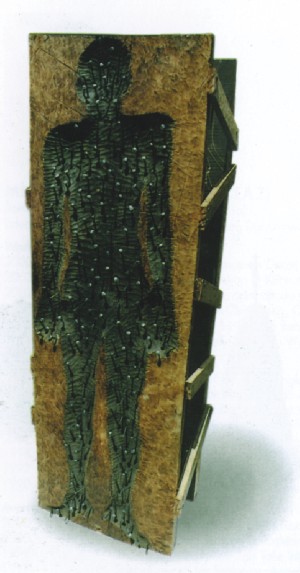The
Duo
A married
couple explores the marriage of sculpture and
painting in an art show
Mustafa
Zaman
The
duo: Fahmida Akhter Kakoli and Hasanur Rahman
Reaz are married to each other in real life, but
their artworks are characteristically different.
Two artists, Kakoli with her colourful canvases
and Reaz with his wood-metal sculpture, stand
apart in respect of the media and expression.
Yet there is an underlying similarity in their
art. Both have the willingness to address present
socio-political realites of the world. While Kakoli
uses fragments of human form to address the mayhem
of our time, Reaz devices different contraptions
to deal with the national and international politics
and human condition.
Both the artists put a lot of emphasis on media
manipulation. Kakoli exploits tactile factors
in all of her paintings, she builds her images
putting broad, haphazard brush strokes and bold
lines. Reaz puts cuts and grooves in straight
lines in his wood planks and uses a lot of large
spikes to augment the visual impact of his work.
He also arranges several components to build each
work.
It is the expressionist stance that Kakoli has
chosen. She, in her paintings, realises a colourful
nightmarish look through agglomeration of brushworks,
lines and suggestion of human bodies. But in her
world the formal beauty of expression seem to
want to steal the show. Though, like the expressionists
of European origin, she too tries to discover
a new kind of beauty. Her tendency to abstract
herself from the subject matter has made her canvases
done in acrylic look more like colour compositions
than works exploring individual subject matter.

Nightmare-16
In
paintings like Nightmare-36 and Nightmare-37 this
tendency subsides to make way for her subjects
to gain control of the composition. In both the
works she tries out different methods of composition.
Her works are bathing in colours, as such she
needs to minimize her application of painterly
brushworks. In Nightmare-35 she develops her images
of three figures vaguely looking like soldiers
in their high-ankle boots with minimum effort.
This effortlessness she needs to cultivate.
In a few works she shows a tendency to emulate
childlike simplicity. But, her work, with their
overt display of artistic prowess, grounds her
firmly in the mature concept of painting. It is
this truth that Kakoli will have to accept fully,
and by avoiding so called spontaneous expression
she will have to try to put her concepts as clearly
as her subject merits.
Reaz, with his different contraptions made out
of wood and metal spikes, tackles each idea in
an individual manner. His subjects are ambitious.
“American Toys", “Eternal Victim", “Infected
Terrorism”--these are the titles that the artist
came up with. But he employs symbolism, and weaker
ones at that, enthusiastically, as in “Infected
Terrorism”, where big metal spikes swarm the two
horizontal wooden forms of dissimilar height.
This work, without its reference to the title,
looks like a mere composition with the elements.
It is about this aspect of his work that Reaz
needs to do a lot of rethinking.
His big presentation, the “Eternal Victim” is
a work where he has successfully accomplished
his goal. He wanted to present man afflicted by
affairs of the society, state or the world order.
“I wanted to convey that ordinary man has always
been in a helpless condition, and their destiny
has always been in the hands of others. Since
the time immemorial men has been victims,” asserts
Reaz.

Enternal Victim
This
work that depicts the victim and its condition
is Reaz's most ambitious piece. This has four
sides; it is a box-like contrivance. Two massive
planks are held together by wooden structures.
The planks are etched with images, a human on
one side and a tapering form on the other. The
figure is embellished with heads of big nails,
the nails are hammered through the plank all the
way and their tails are visible from the side.
Reaz's works often want to veer towards an expressionist
mode, should he abandon his forced symbolism,
his works would find a proper vehicle in expressionism
alone. He should also give his process of building
contraption-like pieces a second thought. It seems
obvious that it would suit his intention if planks
are hung on the wall. In Bangladesh, sculpture
follows an age-old European tradition; no one
ever explored the possibility of putting it on
the wall.
These two artists are standing at the threshold
of their career. Both of them are eager to explore
hitherto uncharted areas. But this eagerness alone
cannot make their dream come true, what these
young couple need to invest in their work is the
play with newer associations and ideas. |


